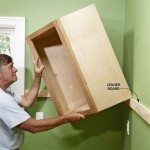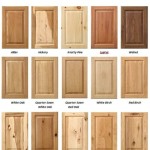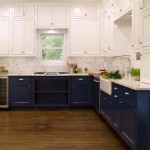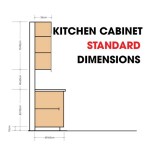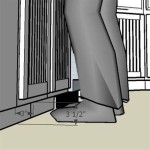How To Get Rid Of Yellow Stains On White Kitchen Cabinets
White kitchen cabinets are a popular design choice, lending a clean and bright aesthetic to the heart of the home. However, over time, these pristine surfaces can develop unsightly yellow stains, detracting from their visual appeal. Understanding the causes of this discoloration and employing appropriate cleaning methods are essential for maintaining the beauty and longevity of white kitchen cabinets.
The yellowing of white kitchen cabinets is a common issue with several contributing factors. Grease and cooking splatters are primary culprits, as airborne particles settle on cabinet surfaces, creating a sticky film that attracts dust and grime. Prolonged exposure to sunlight can also cause yellowing, particularly on cabinets with lighter paint finishes. The type of paint or coating used on the cabinets can also play a role; some materials are more prone to discoloration than others. Furthermore, the aging process of the cabinet materials themselves can contribute to a yellowed appearance.
Regular cleaning is the first line of defense against yellowing. Wiping down cabinets frequently with a mild detergent and water solution can prevent the buildup of grease and grime. However, when yellow stains have already developed, more targeted cleaning solutions and techniques are required. Several effective methods can be employed to remove yellow stains from white kitchen cabinets without damaging the finish.
Key Point 1: Preparing for Cleaning
Before embarking on any cleaning process, proper preparation is crucial. This involves gathering the necessary cleaning supplies and taking steps to protect the surrounding areas. The following steps outline the essential preparation for cleaning yellowed kitchen cabinets:
Gather Cleaning Supplies: A variety of cleaning solutions can be effective in removing yellow stains. These include mild dish soap, baking soda, vinegar, hydrogen peroxide, and commercially available cabinet cleaners. Soft cloths, sponges, and a soft-bristled brush are also necessary. Avoid using abrasive scrub pads or steel wool, as these can scratch the cabinet finish.
Protect Surrounding Areas: Cover countertops, floors, and appliances near the cabinets to protect them from spills and splatters. Drop cloths, plastic sheeting, or even old towels can effectively shield these surfaces. Consider removing cabinet hardware, such as knobs and pulls, to facilitate thorough cleaning.
Test Cleaning Solution: Before applying any cleaning solution to the entire cabinet surface, test it on an inconspicuous area, such as the inside of a cabinet door or a corner. This will help determine if the solution causes any discoloration or damage to the finish. Allow the test area to dry completely before proceeding.
Safety Precautions: When using cleaning solutions, particularly those containing chemicals like hydrogen peroxide or ammonia, wear gloves and eye protection to prevent skin and eye irritation. Ensure proper ventilation in the kitchen by opening windows or turning on the exhaust fan.
Key Point 2: Cleaning Methods for Yellow Stains
Once the preparation is complete, select an appropriate cleaning method based on the severity of the stains and the type of cabinet finish. Several effective cleaning solutions and techniques can be used to remove yellow stains from white kitchen cabinets:
Mild Dish Soap and Water: This is the gentlest cleaning method and is suitable for light yellowing and general cleaning. Mix a small amount of mild dish soap with warm water to create a soapy solution. Dip a soft cloth or sponge into the solution, wring out excess water, and gently wipe the cabinet surfaces. Rinse with a clean, damp cloth and dry thoroughly. This method is effective for removing surface grime and preventing further yellowing.
Baking Soda Paste: Baking soda is a mild abrasive that can help remove stubborn stains. Mix baking soda with water to create a paste. Apply the paste to the stained areas and gently rub with a soft cloth or sponge. Allow the paste to sit for a few minutes before rinsing with a clean, damp cloth. Dry thoroughly. Baking soda is particularly effective for removing grease and food stains.
Vinegar Solution: Vinegar's acidity can help dissolve grease and grime. Mix equal parts white vinegar and water in a spray bottle. Spray the solution onto the stained areas and let it sit for a few minutes. Wipe with a clean, damp cloth and dry thoroughly. Vinegar can be used for routine cleaning and can help brighten white surfaces. However, avoid using vinegar on waxed surfaces, as it can damage the finish.
Hydrogen Peroxide: Hydrogen peroxide is a bleaching agent that can be effective for removing more severe yellow stains. Apply 3% hydrogen peroxide directly to the stained areas and let it sit for a few minutes. Wipe with a clean, damp cloth and dry thoroughly. Hydrogen peroxide should be used cautiously, as it can lighten the paint finish. Always test it on an inconspicuous area first. For stubborn stains, a paste of baking soda and hydrogen peroxide can be used.
Commercial Cabinet Cleaners: Many commercially available cabinet cleaners are specifically formulated to remove grease, grime, and stains from kitchen cabinets. Follow the manufacturer's instructions carefully when using these products. Choose a cleaner that is designed for the type of finish on your cabinets (e.g., painted, laminate, or wood). Always test the cleaner on an inconspicuous area before applying it to the entire surface.
Magic Eraser: Melamine sponges, often referred to as Magic Erasers, can be effective for removing stubborn marks and stains. Wet the sponge and gently rub the stained areas. Be cautious when using Magic Erasers, as they can be abrasive and may dull the paint finish if used too aggressively. Test on an inconspicuous area first.
Key Point 3: Maintaining White Cabinets to Prevent Yellowing
Preventing yellow stains from developing in the first place is the most effective strategy for maintaining the pristine appearance of white kitchen cabinets. Implementing a regular cleaning routine and taking preventative measures can significantly reduce the likelihood of yellowing.
Regular Cleaning: Wipe down cabinets regularly with a mild detergent and water solution to remove grease, grime, and food splatters. Aim to clean cabinets at least once a week, or more frequently if cooking produces a lot of grease or splatters. Pay particular attention to areas near the stove and cooktop, as these are more prone to grease buildup.
Proper Ventilation: Use the exhaust fan or open windows when cooking to improve ventilation and reduce the amount of airborne grease and particles that settle on cabinet surfaces. Good ventilation helps to minimize the buildup of greasy film that contributes to yellowing.
Avoid Harsh Chemicals: Avoid using harsh chemicals, abrasive cleaners, or scouring pads on white kitchen cabinets, as these can damage the finish and make them more susceptible to staining. Stick to mild cleaning solutions and soft cloths or sponges.
Minimize Sunlight Exposure: Direct sunlight can contribute to the yellowing of white cabinets. Consider using window treatments, such as blinds or curtains, to reduce sunlight exposure, particularly during the peak hours of the day. This is especially important for cabinets with lighter paint finishes.
Touch-Up Paint: Over time, the finish on white kitchen cabinets may become chipped or scratched. Touch up these areas with matching paint to prevent dirt and grime from penetrating the exposed surfaces. This will also help to maintain a consistent appearance and prevent localized yellowing.
Consider Sealing: For cabinets in high-traffic kitchens, consider applying a sealant to protect the finish and make it easier to clean. A polyurethane sealant can provide a durable, protective layer that resists stains and scratches. Choose a sealant that is compatible with the type of paint or coating on your cabinets. Follow the manufacturer's instructions carefully when applying sealant.
Address Spills Immediately: Clean up spills and splatters immediately to prevent them from setting into the cabinet surface and causing stains. The longer a spill remains on the cabinet, the more difficult it will be to remove.
By implementing these preventative measures and adhering to a regular cleaning routine, the beauty and longevity of white kitchen cabinets can be preserved, ensuring a bright and welcoming kitchen environment.
In addition to the cleaning methods outlined above, steam cleaning can also be a viable option for removing yellow stains. A steam cleaner uses hot steam to loosen dirt and grime, making it easier to wipe away. When using a steam cleaner, use a low setting and keep the nozzle moving to avoid damaging the cabinet finish. Dry the cabinets thoroughly after steam cleaning.
For extremely stubborn stains that do not respond to conventional cleaning methods, professional cleaning services may be necessary. Professional cleaners have access to specialized equipment and cleaning solutions that can effectively remove even the most difficult stains. They can also assess the condition of the cabinets and recommend appropriate cleaning and restoration techniques.
Ultimately, the key to maintaining white kitchen cabinets and preventing them from yellowing is a combination of regular cleaning, preventative measures, and prompt attention to spills and stains. By following these guidelines, homeowners can enjoy the beauty and brightness of white kitchen cabinets for years to come.

How To Clean Sticky Grease Off Kitchen Cabinets Ovenclean

How To Clean White Kitchen Cabinets 3 Best Ways Avoid Abbotts At Home

How To Clean Stains From Painted White Kitchen Cabinets Southwest

Removing Yellow Stains From A White Countertop Hometalk

How To Get Rid Of Kitchen Cabinet Stains

How To Remove Yellow Stains On Quartz Countertop Kitchen Cabinet

How To Remove Yellow Cooking Odor Stain From White Kitchen Cabinet Doors

How To Clean Yellowing Kitchen Cabinets Painted White Dengarden

How To Remove Yellow Cooking Odor Stain From White Kitchen Cabinet Doors

How To Clean White Painted Cabinets That Have Yellowed Hunker
Related Posts


